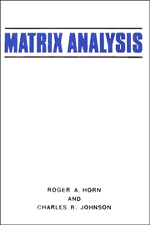Book contents
- Frontmatter
- Contents
- Preface
- Chapter 0 Review and miscellanea
- Chapter 1 Eigenvalues, eigenvectors, and similarity
- Chapter 2 Unitary equivalence and normal matrices
- Chapter 3 Canonical forms
- Chapter 4 Hermitian and symmetric matrices
- Chapter 5 Norms for vectors and matrices
- Chapter 6 Location and perturbation of eigenvalues
- Chapter 7 Positive definite matrices
- Chapter 8 Nonnegative matrices
- Appendices
- A Complex numbers
- B Convex sets and functions
- C The fundamental theorem of algebra
- D Continuous dependence of the zeroes of a polynomial on its coefficients
- E Weierstrass's theorem
- References
- Notation
- Index
C - The fundamental theorem of algebra
Published online by Cambridge University Press: 05 June 2012
- Frontmatter
- Contents
- Preface
- Chapter 0 Review and miscellanea
- Chapter 1 Eigenvalues, eigenvectors, and similarity
- Chapter 2 Unitary equivalence and normal matrices
- Chapter 3 Canonical forms
- Chapter 4 Hermitian and symmetric matrices
- Chapter 5 Norms for vectors and matrices
- Chapter 6 Location and perturbation of eigenvalues
- Chapter 7 Positive definite matrices
- Chapter 8 Nonnegative matrices
- Appendices
- A Complex numbers
- B Convex sets and functions
- C The fundamental theorem of algebra
- D Continuous dependence of the zeroes of a polynomial on its coefficients
- E Weierstrass's theorem
- References
- Notation
- Index
Summary
One historical motivation for introducing the complex numbers C was that polynomials with real coefficients may have nonreal complex zeroes. For example, the quadratic formula reveals that the equation x2 - 2x + 2 = 0 has roots (solutions) {1 + i, 1 -i}. All zeroes of any polynomial with real coefficients, however, are contained in C. In fact, if the field of possible coefficients is extended to C, all zeroes of all polynomials with complex coefficients are still contained in C. Thus, C is an example of an algebraically closed field; that is, there is no field F such that C is a subfield of F, and such that there is a polynomial with coefficients from C and with a zero in F that is not in C.
The fundamental theorem of algebra states that any polynomial p(x), of degree at least 1, with complex coefficients has at least one zero z [i.e., z is a root of the equation p(x) = 0] among the complex numbers. Using synthetic division, if z is zero of p(x), then x - z divides p(x); that is, p(x) = (x - z)q(x), in which q(x) is a polynomial with complex coefficients, whose degree is 1 smaller than that of p(x). The zeroes of p(x) are then those of q(x), together with z. The following is a consequence of the fundamental theorem of algebra.
Theorem. A polynomial of degree n ≥ 1 with complex coefficients has, counting multiplicities, exactly n zeroes among the complex numbers.
Information
- Type
- Chapter
- Information
- Matrix Analysis , pp. 537 - 538Publisher: Cambridge University PressPrint publication year: 1985
